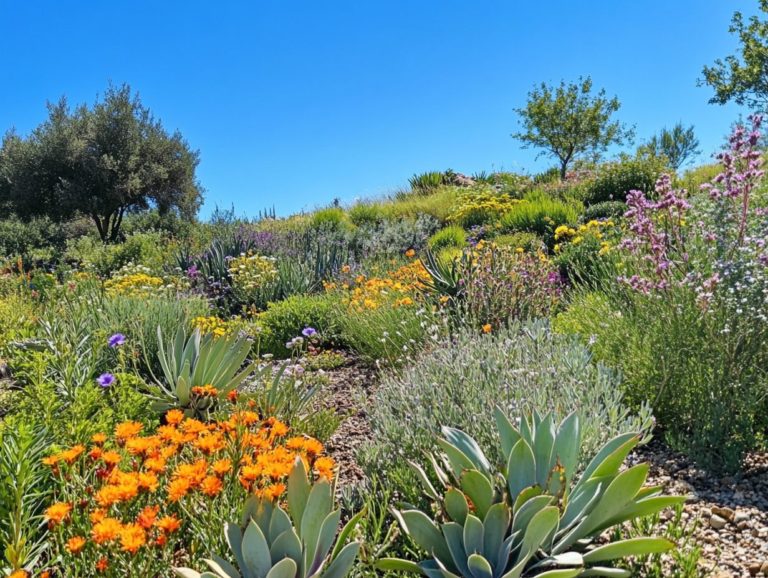The Role of Organic Matter in Drought Gardening
Drought gardening is becoming increasingly essential as climate change intensifies water scarcity in many regions. This practice focuses on cultivating resilient gardens that thrive even in dry conditions, offering both aesthetic and ecological benefits.
Incorporating organic matter into your gardening routine significantly enhances soil health, enabling your plants to better withstand drought.
This guide will empower you with the vital knowledge to transform your garden and thrive despite drought! We will explore the role of organic matter, effective application techniques, and additional strategies for maintaining a flourishing drought garden. Whether you re an experienced gardener or just starting out, this information will equip you with what you need to succeed in challenging conditions.
Contents
- Key Takeaways:
- Unlocking the Secrets of Drought Gardening
- The Importance of Organic Matter in Drought Gardening
- Using Organic Matter in Drought Gardening
- Other Strategies for Drought Gardening
- Maintaining a Drought Garden
- Frequently Asked Questions
- Why is organic matter vital for successful drought gardening?
- How does organic matter improve soil structure in drought gardening?
- What are some examples of organic matter used in drought gardening?
- How does organic matter contribute to water retention in drought gardening?
- What nutrients does organic matter provide in drought gardening?
- Can too much organic matter be harmful in drought gardening?
Key Takeaways:

- Organic matter improves soil structure, retains moisture, and provides essential nutrients for plants to thrive in dry conditions.
- Using different types of organic matter, like compost, mulch, and cover crops, can greatly benefit a drought garden and increase its resilience to water scarcity.
- Use organic matter and implement water conservation methods to help maintain a thriving drought garden with minimal water usage.
Unlocking the Secrets of Drought Gardening
Understanding drought gardening is crucial in today s climate, where water scarcity poses significant challenges for sustainable agriculture. This approach emphasizes using organic matter to enhance soil properties, improving water retention and nutrient availability.
By adopting effective agricultural practices, such as incorporating soil amendments materials added to soil to improve its physical or chemical properties and fostering soil health, you can cultivate resilient agro-ecosystems that thrive in arid conditions. This supports both crop production and ecological balance.
This knowledge is particularly important for regions like Brazil’s Amazon and Central American countries, including Guatemala, Honduras, and Nicaragua, where droughts can dramatically affect crop yields.
Defining Drought Gardening and Its Benefits
Drought gardening is a sustainable approach for optimizing water use in agriculture, especially in dry areas. This method focuses on enhancing soil moisture retention through organic matter, allowing you to boost crop production even when water is scarce.
By using techniques like mulching covering the soil with organic material and cover cropping planting crops specifically to improve soil health you can significantly improve soil quality while conserving water. This practice enhances moisture retention and promotes nutrient cycling, making key minerals available to your plants, even in arid conditions.
Using these methods fosters greater drought resistance and contributes to a more resilient ecosystem. Organic materials enrich the soil structure, creating a thriving habitat for beneficial microbes and reducing reliance on synthetic fertilizers.
Adopting a drought gardening strategy plays a pivotal role in promoting ecological sustainability and efficiency, ensuring your gardening efforts thrive despite the challenges of dry weather.
The Importance of Organic Matter in Drought Gardening
Organic matter is essential for drought gardening, as it dramatically enhances soil properties, leading to improved soil health and increased plant resilience. Understanding the role of shade in drought gardening can also play a crucial part in this process.
By boosting nutrient availability and enhancing soil moisture retention, organic matter nurtures beneficial soil fauna and microorganisms that promote biological activity, which is crucial for thriving crops in arid conditions.
Embracing this natural resource not only enriches your garden but also fortifies it against the challenges of drought.
Start implementing these drought gardening techniques today and take a step toward a sustainable future!
How Organic Matter Helps Plants Survive Drought
Organic matter plays a vital role in ensuring that plants survive droughts by boosting water retention in the soil. This enhancement guarantees a steady supply of nutrients even during times of scarce rainfall. Additionally, using native plants in drought gardening is essential for supporting the tiny living things in the soil that keep your plants healthy and strong in challenging conditions.
Take fungi and bacteria, for instance. They are key players in breaking down organic matter into nutrients that plants can easily absorb. There is a type of fungi that helps plants, forming beneficial partnerships with plant roots to access water and minerals more efficiently.
Then there are earthworms, which aerate the soil and produce nutrient-rich castings. This process promotes stronger root growth and resilience against drought stress. Incorporating organic matter not only improves the soil’s moisture retention but also cultivates a thriving ecosystem that enhances plant health during dry spells.
Using Organic Matter in Drought Gardening

Using organic matter wisely can transform your drought garden! By integrating soil amendments like crop residues, biochar, and charcoal, you can significantly improve your soil management practices.
This thoughtful approach leads to better moisture retention and promotes overall plant health, even in dry conditions.
Types of Organic Matter to Use
You can explore several types of organic matter that are effective in drought gardening, including crop residues, compost, biochar, and mulch. Each of these contributes uniquely to enhancing soil health and boosting moisture retention.
Using crop residues, such as leftover stalks and leaves from previous harvests, enriches the soil with essential nutrients and acts as a natural barrier against soil erosion. Compost, made from decomposed organic materials, improves soil structure and nurtures a diverse community of tiny living things, crucial for moisture retention.
Then there’s biochar, a special type of charcoal that improves soil aeration and holds water, making it especially beneficial in arid regions. Mulch, whether you choose organic options like straw or wood chips, conserves moisture by shading the soil and minimizing evaporation.
By using these materials together, you can create a thriving ecosystem that withstands the challenges of drought while promoting sustainable gardening practices.
Application Techniques
Application techniques for incorporating organic matter in drought gardening can take various forms, including soil incorporation, mulching, and composting. Understanding the role of organic matter in soil health is essential, as each technique is designed to enhance water retention and improve soil health.
It s crucial to begin with high-quality organic matter, such as well-decomposed compost or aged manure. Use a garden fork or tiller to break up the soil, ensuring the organic material is evenly mixed into the top six to eight inches. This process fosters microbial activity, boosting nutrient availability.
Mulching involves applying a protective layer of organic material like straw or wood chips around your plants. This technique effectively reduces evaporation and helps regulate soil temperature. Meanwhile, composting provides a slow release of nutrients and can improve soil structure.
By embracing these methods, you not only maximize the benefits of organic matter but also equip your garden to endure the challenges of prolonged dry spells.
Other Strategies for Drought Gardening
Implementing additional strategies for drought gardening is essential for maximizing resource efficiency and ensuring plant survival during dry periods. Incorporating effective water conservation methods and choosing drought-tolerant plants are pivotal to cultivating a sustainable garden.
By being intentional in your approach, you can create a flourishing oasis even in challenging conditions. Start incorporating these techniques today and watch your garden thrive, even in tough conditions!
Water Conservation Methods
Water conservation methods in drought gardening are essential, especially for maintaining soil moisture and ensuring efficient water use in arid climates where rain is rare.
Adopting practices like drip irrigation and mulching can significantly reduce water loss while nurturing healthy plants. Drip irrigation delivers water straight to the root zone, which is the area around the roots. This minimizes evaporation and runoff, effectively giving your plants a refreshing drink without the extra splash.
Utilizing rain barrels allows you to capture precious rainwater, turning it into an eco-friendly resource for your garden.
Techniques such as contour gardening and creating swales help direct water efficiently, ensuring it penetrates the soil instead of running off. These strategies not only boost soil moisture levels but also promote robust plant health, creating a sustainable garden you can be proud of.
Drought-Tolerant Plant Selection

Selecting drought-tolerant plants is key for your drought gardening success. These amazing crops thrive in low-water conditions while maintaining robust production.
This adaptability allows them to endure dry spells, keeping your garden vibrant and productive. Consider plants like lavender and agave; they flourish in sandy or rocky soils.
Native grasses such as blue grama and buffalo grass showcase resilience in both drought and varying soil conditions.
Incorporating these plants conserves water and cultivates a balanced ecosystem, providing habitat for local wildlife while minimizing the need for chemical fertilizers and pesticides. By choosing these hardy species, you create sustainable landscapes that are beautiful and environmentally friendly.
Maintaining a Drought Garden
Maintaining a drought garden requires your unwavering care and attention to ensure the long-term vitality of both the soil and plants. Essential practices include monitoring soil health, replenishing organic matter, and using ecological strategies that nurture a resilient ecosystem.
Committing to these practices allows you to cultivate not just a garden but a thriving habitat that stands the test of time.
Regular Care and Maintenance Tips
Regular maintenance of your drought garden involves establishing a consistent watering schedule and replenishing organic matter to sustain soil health.
Prioritize deep watering techniques that encourage roots to reach deeper into the soil, enhancing drought resistance. Implementing mulch can dramatically reduce evaporation rates and maintain optimal soil temperature.
Integrating organic matter like compost improves nutrient availability and enhances moisture retention an essential factor in arid conditions.
Routine monitoring of soil indicators, such as moisture levels and pH balance, ensures your plants receive optimal care, allowing them to thrive even in challenging environments.
Frequently Asked Questions
Why is organic matter vital for successful drought gardening?
Organic matter plays a crucial role in drought gardening by improving soil structure, increasing water retention, and providing essential nutrients for plant growth, as detailed in understanding soil health in drought gardening.
How does organic matter improve soil structure in drought gardening?

Organic matter binds with soil particles, creating pore spaces that allow for better water infiltration and root penetration. This results in looser, well-aerated soil that retains moisture longer, enhancing soil moisture content.
What are some examples of organic matter used in drought gardening?
Common sources of organic matter include compost, manure, leaf litter, and grass clippings. These materials can be added to the soil or used as mulch to help retain moisture.
This improves soil depth and soil cover.
How does organic matter contribute to water retention in drought gardening?
Organic matter absorbs water like a sponge, holding onto it for longer periods. This prevents the soil from drying out quickly and keeps plants hydrated during droughts.
It also boosts nutrient supply and microbial activity.
What nutrients does organic matter provide in drought gardening?
Organic matter contains essential nutrients like nitrogen, phosphorus, and potassium. These nutrients are released slowly into the soil, helping plants thrive even in dry conditions.
This process improves nutrient cycling too.
Can too much organic matter be harmful in drought gardening?
Yes, excessive organic matter can negatively affect drought gardening. It can lead to waterlogged soil and inhibit root growth, reducing overall crop yield.
Finding the right amount is crucial for the best results!






